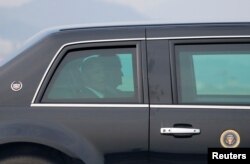“ພວກເຮົາມາກ່າວເຖິງພະລັງອັນຮ້າຍແຮງ ທີ່ໄດ້ປ່ອຍລົງມາເປັນເວລາບໍ່ນານທີ່ຜ່ານມາ ນີ້.” ປະທານາທິບໍດີສະຫະລັດ ທ່ານ Barack Obama ໄດ້ກ່າວຢູ່ທີ່ນະຄອນ Hiroshi- ma ປະເທດຍີ່ປຸ່ນ ບ່ອນທີ່ເຮືອບິນອາເມຣິກັນໄດ້ຖີ້ມລະເບີດປະລະມານູ ລູກທຳອິດຂອງ ໂລກ ລົງໃສ່ເມື່ອວັນທີ 6 ເດືອນສິງຫາ ປີ 1945 ເພື່ອເຮັດໃຫ້ສົງຄາມໂລກຄັ້ງທີສອງສິ້ນ ສຸດລົງນັ້ນ.
ທ່ານ Obama ເປັນປະທານາທິບໍດີສະຫະລັດ ຜູ້ທຳອິດທີ່ຍັງຢູ່ໃນຕຳແໜ່ງ ໄປຢ້ຽມຢາມນະຄອນດັ່ງກ່າວໃນວັນສຸກມື້ນີ້.
“ພວກເຮົາມາສະແດງຄວາມເສົ້າສະຫລົດໃຈແກ່ຜູ້ເສຍຊີວິດ” ຜູ້ນຳສະຫະລັດໄດ້ກ່າວ ຫລັງຈາກທ່ານແລະນາຍົກລັດຖະມົນຕີ ຍີ່ປຸ່ນ ທ່ານ Shinzo Abe ຕ່າງ ກໍໄດ້ວາງພວງມາລາ ທີ່ອະນຸສອນສະຖານສັນຕິພາບ.
ປະທານາທິບໍດີ Obama ໄດ້ກ່າວດ້ວຍຄວາມເສົ້າສະຫລົດໃຈວ່າ “ພວກເຮົາໄດ້ແບ່ງປັນຄວາມຮັບຜິດຊອບ ເພື່ອເບິ່ງຕາຕໍ່ຕາຂອງປະຫວັດສາດ. ພວກເຮົາຕ້ອງຖາມວ່າພວກເຮົາຕ້ອງເຮັດຢ່າງໃດໃຫ້ແຕກຕ່າງເພື່ອຫລຸດຜ່ອນຄວາມເຈັບປວດນັ້ນອີກ. ພວກເຮົາຕ້ອງໄດ້ວາດພາບຄືນໃໝ່ຂອງການຕິດຕໍ່ຫາກັນ ແລະກັນໃນນາມບັນດາສະມາຊິກເຜົ່າພັນມະນຸດຊາດ.”
ຫລັງຈາກກ່າວຄຳປາໄສແລ້ວ ຜູ້ນຳສະຫະລັດ ກໍໄດ້ໂອ້ລົມກັບບັນດາຜູ້ລອດຊີວິດມາໄດ້ທີ່ນະຄອນ Hiroshima ທີ່ໄດ້ເຂົ້າຮ່ວມພິທີ ສຳພັດມື ແລະກອດຜູ້ຊາຍຊະລາຄົນນຶ່ງ ດ້ວຍຄວາມໂສກເສົ້າ.
ບໍ່ເທົ່າໃດຊົ່ວໂມງກ່ອນກຳໜົດການໄປເຖິງຂອງທ່ານນັ້ນ ທ່ານ Obama ໄດ້ພົບປະກັບ ທະຫານສະຫະລັດ ແລະທະຫານຍີ່ປຸ່ນ ທີ່ຖານທັບອາກາດ Iwakuni ບໍ່ໄກຈາກປານໃດ ຈາກນະຄອນ Hiroshima ໂດຍກ່າວຕໍ່ພວກທະຫານເຫລົ່າ ນັ້ນວ່າ ການຢ້ຽມຢາມຂອງທ່ານ “ເປັນໂອກາດໃຫ້ກຽດລະນຶກເຖິງຜູ້ທີ່ເສຍຊີວິດທັງໝົດຢູ່ໃນສົງຄາມໂລກຄັ້ງທີ່
ສອງ.”ປະທານາທິບໍດີ ກ່າວວ່າ “ມັນເປັນການໃຫ້ການຢືນຢັນວ່າ ເຖິງແມ່ນເປັນເລື້ອງ ທີ່ເຈັບແສບທີ່ສຸດທີ່ແບ່ງແຍກ ແຕ່ກໍສາ ມາດເປັນຂົວເຊື່ອມຫາກັນໄດ້. ສອງປະເທດແມ່ນ ສາມາດກາຍມາ ບໍ່ພໍພຽງເປັນ ພາຄີຮ່ວມງານເທົ່ານັ້ນ ແຕ່ເປັນເພື່ອນທີ່ດີເລີດ" ໃນຄຳເວົ້າ ທີ່ກ່າວເຖິງຍີ່ປຸ່ນ.
ຫລັງຈາກກ່າວຄຳປາໄສແລ້ວ ຜູ້ນຳສະຫະລັດ ກໍໄດ້ໂອ້ລົມກັບບັນດາຜູ້ລອດຊີ ວິດມາໄດ້ທີ່ນະຄອນ Hiroshima ທີ່ໄດ້ເຂົ້າຮ່ວມພິທີ ສຳພັດມື ແລະກອດຜູ້ຊາຍຊະລາຄົນນຶ່ງ ດ້ວຍຄວາມໂສກເສົ້າ.
ບໍ່ເທົ່າໃດຊົ່ວໂມງກ່ອນກຳໜົດການໄປເຖິງຂອງທ່ານນັ້ນ ທ່ານ Obama ໄດ້ພົບປະກັບທະຫານສະຫະລັດ ແລະທະຫານຍີ່ປຸ່ນ ທີ່ຖານທັບອາກາດ Iwakuni ບໍ່ໄກຈາກປານໃດ ຈາກນະຄອນ Hiroshima ໂດຍກ່າວຕໍ່ພວກທະຫານເຫລົ່າ ນັ້ນວ່າ ການຢ້ຽມຢາມຂອງທ່ານ “ເປັນໂອກາດໃຫ້ກຽດລະນຶກເຖິງຜູ້ທີ່ເສຍຊີວິດທັງໝົດຢູ່ໃນສົງຄາມໂລກຄັ້ງທີ່ສອງ.” ປະທານາທິບໍດີ ກ່າວວ່າ “ມັນເປັນການໃຫ້ການຢືນຢັນວ່າ ເຖິງແມ່ນເປັນເລື້ອງ ທີ່ເຈັບແສບທີ່ສຸດທີ່ແບ່ງແຍກ ແຕ່ກໍສາ ມາດເປັນຂົວເຊື່ອມຫາກັນໄດ້. ສອງປະເທດແມ່ນສາມາດກາຍມາ ບໍ່ພໍພຽງເປັນ ພາຄີຮ່ວມງານເທົ່ານັ້ນ ແຕ່ເປັນເພື່ອນທີ່ດີເລີດ" ໃນຄຳເວົ້າທີ່ກ່າວເຖິງຍີ່ປຸ່ນ.
We come to ponder the terrible force unleashed in a not-so-distant past," U.S. President Barack Obama said at the Japanese city of Hiroshima where an American warplane dropped the world's first atomic bomb on August 6, 1945 toward the end of World War Two.
Obama became the first sitting U.S. president Friday to visit the city.
"We come to mourn the dead," the U.S. leader said after he and Japanese Prime Minister Shinzo Abe each placed a wreath at the Peace Memorial.
"We have a shared responsibility to look directly in the eye of history. We must ask what we must do differently to curb such suffering again," a solemn Obama said. "We must reimagine our connection to one another as members of the human race."
After his remarks, the U.S. leader greeted Hiroshima survivors attending the ceremony, shaking hands and embracing one elderly gentleman who was overcome with emotion.
Hours before his scheduled arrival, Obama met with U.S. and Japanese troops at Iwakuni air station, not far from Hiroshima, telling the troops his visit "is an opportunity to honor the memory of all who were lost in WWII." The president said, "It's a testament to how even the most painful divides can be bridged. How two nations can become not just partners but the best of friends," in reference to Japan.
The president had said earlier he will not apologize for the decision then president Harry Truman made to drop the A-bomb on Hiroshima, killing 80,000 people instantly and wiping out 90 percent of the city. Tens of thousands more would later die of radiation exposure.
Obama said recently he knows "as somebody who has now sat in this position for the last seven and a half years, that every leader makes very difficult decisions, particularly during war time."
The decision to bomb Hiroshima was controversial. Several of Truman's top military advisers, including future president Dwight Eisenhower, objected and favored the conventional bombing already going on in Japan. Truman, however, was seeking a quick end to the war.
Three days after Hiroshima, the U.S. dropped another atomic bomb on Nagasaki, killing an estimated 40,000 people with 20,000 to 40,000 more dying in the ensuing months.
On August 15, 1945, Japanese Emperor Hirohito announced Japan's unconditional surrender.
Obama said at the Peace Memorial Hiroshima and Nagasaki should become known "as the start of our own awakening."








